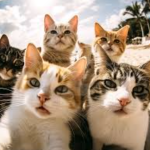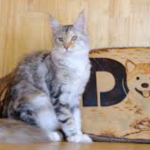Your cat’s tail isn’t just a fluffy appendage; it’s a powerful communication tool that reveals much about their mood and feelings. Alongside their eyes, ears, and body postures, a cat’s tail provides vital cues to decode their emotional state. By learning to interpret your cat’s tail language, you can forge a deeper, more trusting relationship with your feline companion and address their needs more effectively.
Deciphering Tail Positions:
- Upright Tail: When your cat’s tail is held high, it signals sociability and confidence. This posture often accompanies friendly approaches, indicating openness to interaction. Embrace these moments for cuddles or playtime, as your cat is in a welcoming mood.
- Question Mark or Hook Tail: A tail that curves like a question mark while upright signifies a happy and approachable mood. It’s another invitation to engage with your cat, although most cats prefer gentle petting around their facial glands rather than on their tail.
- Lowered Tail: If your cat’s tail is lowered, especially below their back level or tucked between their legs, it’s a sign of fear or anxiety. In severe cases, it could indicate pain or extreme distress. It’s crucial to create a stress-free environment and refrain from interactions during this time.
- Fluffed Up Tail: When your cat’s tail fluffs up along with an arched back, it indicates a startled or frightened state due to sudden threats. This defensive stance implies a desire to be left alone. To reduce stress, eliminate any perceived threats from the environment.
- Tail Wrapped Around the Body: A cat sitting or lying down with its tail curled around its body signifies fear, defensiveness, pain, or illness. Cease interactions immediately and ensure a calm atmosphere for your cat.
Interpreting Tail Movements:
- Thrashing Tail: This movement signifies irritation, annoyance, or anger. Your cat may be signaling discomfort or asking you to stop a particular action. Ignoring this signal might escalate to aggressive behavior.
- Twitching End of the Tail: Cats twitch their tails during play or when mildly irritated. It’s essential to consider the context and other accompanying behaviors to understand their mood accurately.
- Swishing Tails: A slow swishing motion indicates intense focus, often observed during playful moments or while observing something intriguing. It might precede a playful pounce, so allow your cat to engage in their curiosity.
- Tail Quivers: Quivering tails convey excitement, particularly upon seeing you or another cat. However, when held upright against a surface, it might signal marking behavior.
Tail Wrapping and Social Interaction:
- Tail Wrapping Around People: Similar to a handshake or hug, tail wrapping signifies an affinity for interaction. It’s a warm and positive gesture from your cat, displaying a willingness to engage.
Understanding your cat’s tail language goes a long way in fostering a harmonious relationship. By paying attention to these subtle cues, you can ensure your feline friend feels secure, comfortable, and understood.




